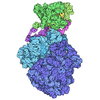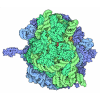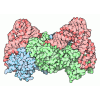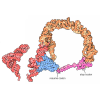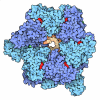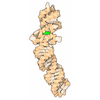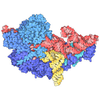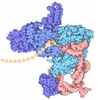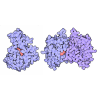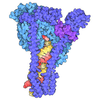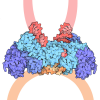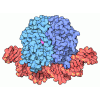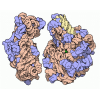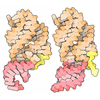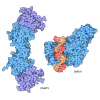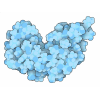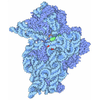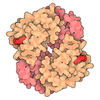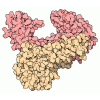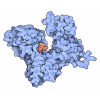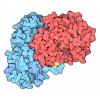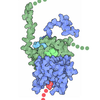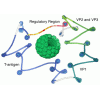+ Open data
Open data
- Basic information
Basic information
| Entry | Database: PDB / ID: 8yny | ||||||
|---|---|---|---|---|---|---|---|
| Title | Structure of Cas9-sgRNA ribonucleoprotein bound to nucleosome | ||||||
 Components Components |
| ||||||
 Keywords Keywords | NUCLEAR PROTEIN / Cas9 / Nucleosome / Complex | ||||||
| Function / homology |  Function and homology information Function and homology informationmaintenance of CRISPR repeat elements / negative regulation of tumor necrosis factor-mediated signaling pathway / negative regulation of megakaryocyte differentiation / protein localization to CENP-A containing chromatin / Chromatin modifying enzymes / Replacement of protamines by nucleosomes in the male pronucleus / CENP-A containing nucleosome / Packaging Of Telomere Ends / 3'-5' exonuclease activity / Recognition and association of DNA glycosylase with site containing an affected purine ...maintenance of CRISPR repeat elements / negative regulation of tumor necrosis factor-mediated signaling pathway / negative regulation of megakaryocyte differentiation / protein localization to CENP-A containing chromatin / Chromatin modifying enzymes / Replacement of protamines by nucleosomes in the male pronucleus / CENP-A containing nucleosome / Packaging Of Telomere Ends / 3'-5' exonuclease activity / Recognition and association of DNA glycosylase with site containing an affected purine / Cleavage of the damaged purine / Deposition of new CENPA-containing nucleosomes at the centromere / telomere organization / Recognition and association of DNA glycosylase with site containing an affected pyrimidine / Cleavage of the damaged pyrimidine / Interleukin-7 signaling / RNA Polymerase I Promoter Opening / epigenetic regulation of gene expression / Inhibition of DNA recombination at telomere / Assembly of the ORC complex at the origin of replication / Meiotic synapsis / SUMOylation of chromatin organization proteins / Regulation of endogenous retroelements by the Human Silencing Hub (HUSH) complex / DNA methylation / Condensation of Prophase Chromosomes / Chromatin modifications during the maternal to zygotic transition (MZT) / SIRT1 negatively regulates rRNA expression / HCMV Late Events / ERCC6 (CSB) and EHMT2 (G9a) positively regulate rRNA expression / PRC2 methylates histones and DNA / innate immune response in mucosa / Regulation of endogenous retroelements by KRAB-ZFP proteins / DNA endonuclease activity / Defective pyroptosis / HDACs deacetylate histones / Regulation of endogenous retroelements by Piwi-interacting RNAs (piRNAs) / Nonhomologous End-Joining (NHEJ) / RNA Polymerase I Promoter Escape / lipopolysaccharide binding / Transcriptional regulation by small RNAs / Formation of the beta-catenin:TCF transactivating complex / Activated PKN1 stimulates transcription of AR (androgen receptor) regulated genes KLK2 and KLK3 / RUNX1 regulates genes involved in megakaryocyte differentiation and platelet function / HDMs demethylate histones / G2/M DNA damage checkpoint / NoRC negatively regulates rRNA expression / B-WICH complex positively regulates rRNA expression / PKMTs methylate histone lysines / DNA Damage/Telomere Stress Induced Senescence / Pre-NOTCH Transcription and Translation / Meiotic recombination / Metalloprotease DUBs / Activation of anterior HOX genes in hindbrain development during early embryogenesis / RMTs methylate histone arginines / Transcriptional regulation of granulopoiesis / HCMV Early Events / antimicrobial humoral immune response mediated by antimicrobial peptide / structural constituent of chromatin / UCH proteinases / antibacterial humoral response / heterochromatin formation / nucleosome / nucleosome assembly / E3 ubiquitin ligases ubiquitinate target proteins / Recruitment and ATM-mediated phosphorylation of repair and signaling proteins at DNA double strand breaks / HATs acetylate histones / RUNX1 regulates transcription of genes involved in differentiation of HSCs / Factors involved in megakaryocyte development and platelet production / MLL4 and MLL3 complexes regulate expression of PPARG target genes in adipogenesis and hepatic steatosis / chromatin organization / Processing of DNA double-strand break ends / Senescence-Associated Secretory Phenotype (SASP) / Oxidative Stress Induced Senescence / defense response to Gram-negative bacterium / defense response to virus / gene expression / killing of cells of another organism / Estrogen-dependent gene expression / Hydrolases; Acting on ester bonds / chromosome, telomeric region / defense response to Gram-positive bacterium / Ub-specific processing proteases / cadherin binding / Amyloid fiber formation / protein heterodimerization activity / negative regulation of cell population proliferation / protein-containing complex / extracellular space / DNA binding / RNA binding / extracellular exosome / extracellular region / nucleoplasm / metal ion binding / nucleus / membrane / cytosol Similarity search - Function | ||||||
| Biological species |  Homo sapiens (human) Homo sapiens (human) Streptococcus pyogenes (bacteria) Streptococcus pyogenes (bacteria) | ||||||
| Method | ELECTRON MICROSCOPY / single particle reconstruction / cryo EM / Resolution: 4.52 Å | ||||||
 Authors Authors | Nagamura, R. / Kujirai, T. / Kusakizako, T. / Hirano, H. / Kurumizaka, H. / Nureki, O. | ||||||
| Funding support |  Japan, 1items Japan, 1items
| ||||||
 Citation Citation |  Journal: Nat Commun / Year: 2024 Journal: Nat Commun / Year: 2024Title: Structural insights into how Cas9 targets nucleosomes. Authors: Reina Nagamura / Tomoya Kujirai / Junko Kato / Yutaro Shuto / Tsukasa Kusakizako / Hisato Hirano / Masaki Endo / Seiichi Toki / Hiroaki Saika / Hitoshi Kurumizaka / Osamu Nureki /  Abstract: The CRISPR-associated endonuclease Cas9 derived from prokaryotes is used as a genome editing, which targets specific genomic loci by single guide RNAs (sgRNAs). The eukaryotes, the target of genome ...The CRISPR-associated endonuclease Cas9 derived from prokaryotes is used as a genome editing, which targets specific genomic loci by single guide RNAs (sgRNAs). The eukaryotes, the target of genome editing, store their genome DNA in chromatin, in which the nucleosome is a basic unit. Despite previous structural analyses focusing on Cas9 cleaving free DNA, structural insights into Cas9 targeting of DNA within nucleosomes are limited, leading to uncertainties in understanding how Cas9 operates in the eukaryotic genome. In the present study, we perform native-polyacrylamide gel electrophoresis (PAGE) analyses and find that Cas9 targets the linker DNA and the entry-exit DNA region of the nucleosome but not the DNA tightly wrapped around the histone octamer. We further determine cryo-electron microscopy (cryo-EM) structure of the Cas9-sgRNA-nucleosome ternary complex that targets linker DNA in nucleosomes. The structure suggests interactions between Cas9 and nucleosomes at multiple sites. Mutants that reduce the interaction between nucleosomal DNA and Cas9 improve nucleosomal DNA cleavage activity in vitro, although inhibition by the interaction between Cas9 and nucleosomes is limited in vivo. These findings will contribute to the development of novel genome editing tools in chromatin. | ||||||
| History |
|
- Structure visualization
Structure visualization
| Structure viewer | Molecule:  Molmil Molmil Jmol/JSmol Jmol/JSmol |
|---|
- Downloads & links
Downloads & links
- Download
Download
| PDBx/mmCIF format |  8yny.cif.gz 8yny.cif.gz | 507.2 KB | Display |  PDBx/mmCIF format PDBx/mmCIF format |
|---|---|---|---|---|
| PDB format |  pdb8yny.ent.gz pdb8yny.ent.gz | 385.3 KB | Display |  PDB format PDB format |
| PDBx/mmJSON format |  8yny.json.gz 8yny.json.gz | Tree view |  PDBx/mmJSON format PDBx/mmJSON format | |
| Others |  Other downloads Other downloads |
-Validation report
| Summary document |  8yny_validation.pdf.gz 8yny_validation.pdf.gz | 1.2 MB | Display |  wwPDB validaton report wwPDB validaton report |
|---|---|---|---|---|
| Full document |  8yny_full_validation.pdf.gz 8yny_full_validation.pdf.gz | 1.3 MB | Display | |
| Data in XML |  8yny_validation.xml.gz 8yny_validation.xml.gz | 70.5 KB | Display | |
| Data in CIF |  8yny_validation.cif.gz 8yny_validation.cif.gz | 107.9 KB | Display | |
| Arichive directory |  https://data.pdbj.org/pub/pdb/validation_reports/yn/8yny https://data.pdbj.org/pub/pdb/validation_reports/yn/8yny ftp://data.pdbj.org/pub/pdb/validation_reports/yn/8yny ftp://data.pdbj.org/pub/pdb/validation_reports/yn/8yny | HTTPS FTP |
-Related structure data
| Related structure data |  39431MC M: map data used to model this data C: citing same article ( |
|---|---|
| Similar structure data | Similarity search - Function & homology  F&H Search F&H Search |
- Links
Links
- Assembly
Assembly
| Deposited unit | 
|
|---|---|
| 1 |
|
- Components
Components
-Protein , 5 types, 9 molecules AEBFCGDHX
| #1: Protein | Mass: 15719.445 Da / Num. of mol.: 2 Source method: isolated from a genetically manipulated source Source: (gene. exp.)  Homo sapiens (human) Homo sapiens (human)Gene: H3C1, H3FA, HIST1H3A, H3C2, H3FL, HIST1H3B, H3C3, H3FC HIST1H3C, H3C4, H3FB, HIST1H3D, H3C6, H3FD, HIST1H3E, H3C7, H3FI, HIST1H3F, H3C8, H3FH, HIST1H3G, H3C10, H3FK, HIST1H3H, H3C11, H3FF, ...Gene: H3C1, H3FA, HIST1H3A, H3C2, H3FL, HIST1H3B, H3C3, H3FC HIST1H3C, H3C4, H3FB, HIST1H3D, H3C6, H3FD, HIST1H3E, H3C7, H3FI, HIST1H3F, H3C8, H3FH, HIST1H3G, H3C10, H3FK, HIST1H3H, H3C11, H3FF, HIST1H3I, H3C12, H3FJ, HIST1H3J Production host:  #2: Protein | Mass: 11676.703 Da / Num. of mol.: 2 Source method: isolated from a genetically manipulated source Source: (gene. exp.)  Homo sapiens (human) Homo sapiens (human)Gene: H4C1, H4/A, H4FA, HIST1H4A, H4C2, H4/I, H4FI, HIST1H4B, H4C3, H4/G, H4FG, HIST1H4C, H4C4, H4/B, H4FB, HIST1H4D, H4C5, H4/J, H4FJ, HIST1H4E, H4C6, H4/C, H4FC, HIST1H4F, H4C8, H4/H, H4FH, ...Gene: H4C1, H4/A, H4FA, HIST1H4A, H4C2, H4/I, H4FI, HIST1H4B, H4C3, H4/G, H4FG, HIST1H4C, H4C4, H4/B, H4FB, HIST1H4D, H4C5, H4/J, H4FJ, HIST1H4E, H4C6, H4/C, H4FC, HIST1H4F, H4C8, H4/H, H4FH, HIST1H4H, H4C9, H4/M, H4FM, HIST1H4I, H4C11, H4/E, H4FE, HIST1H4J, H4C12, H4/D, H4FD, HIST1H4K, H4C13, H4/K, H4FK, HIST1H4L, H4C14, H4/N, H4F2, H4FN, HIST2H4, HIST2H4A, H4C15, H4/O, H4FO, HIST2H4B, H4C16, H4-16, HIST4H4 Production host:  #3: Protein | Mass: 14447.825 Da / Num. of mol.: 2 Source method: isolated from a genetically manipulated source Source: (gene. exp.)  Homo sapiens (human) / Gene: H2AC4, H2AFM, HIST1H2AB, H2AC8, H2AFA, HIST1H2AE / Production host: Homo sapiens (human) / Gene: H2AC4, H2AFM, HIST1H2AB, H2AC8, H2AFA, HIST1H2AE / Production host:  #4: Protein | Mass: 14217.516 Da / Num. of mol.: 2 Source method: isolated from a genetically manipulated source Source: (gene. exp.)  Homo sapiens (human) / Gene: H2BC11, H2BFR, HIST1H2BJ / Production host: Homo sapiens (human) / Gene: H2BC11, H2BFR, HIST1H2BJ / Production host:  #9: Protein | | Mass: 158699.844 Da / Num. of mol.: 1 Source method: isolated from a genetically manipulated source Source: (gene. exp.)  Streptococcus pyogenes (bacteria) / Gene: cas9, csn1, SPy_1046 / Production host: Streptococcus pyogenes (bacteria) / Gene: cas9, csn1, SPy_1046 / Production host:  References: UniProt: Q99ZW2, Hydrolases; Acting on ester bonds |
|---|
-DNA chain , 3 types, 3 molecules IJK
| #5: DNA chain | Mass: 53805.281 Da / Num. of mol.: 1 / Source method: obtained synthetically / Details: Widom 601 / Source: (synth.)  Homo sapiens (human) Homo sapiens (human) |
|---|---|
| #6: DNA chain | Mass: 54534.730 Da / Num. of mol.: 1 / Source method: obtained synthetically / Details: Widom 601 / Source: (synth.)  Homo sapiens (human) Homo sapiens (human) |
| #7: DNA chain | Mass: 5243.396 Da / Num. of mol.: 1 / Source method: obtained synthetically / Details: Widom 601 / Source: (synth.)  Homo sapiens (human) Homo sapiens (human) |
-RNA chain , 1 types, 1 molecules W
| #8: RNA chain | Mass: 31261.604 Da / Num. of mol.: 1 / Source method: obtained synthetically / Source: (synth.)  Streptococcus pyogenes (bacteria) Streptococcus pyogenes (bacteria) |
|---|
-Details
| Has protein modification | N |
|---|
-Experimental details
-Experiment
| Experiment | Method: ELECTRON MICROSCOPY |
|---|---|
| EM experiment | Aggregation state: 3D ARRAY / 3D reconstruction method: single particle reconstruction |
- Sample preparation
Sample preparation
| Component | Name: SpCas9-sgRNA-nucleosome ternary complex / Type: COMPLEX / Entity ID: all / Source: MULTIPLE SOURCES |
|---|---|
| Molecular weight | Experimental value: NO |
| Source (natural) | Organism:  Homo sapiens (human) Homo sapiens (human) |
| Source (recombinant) | Organism:  |
| Buffer solution | pH: 8 |
| Specimen | Conc.: 0.367 mg/ml / Embedding applied: NO / Shadowing applied: NO / Staining applied: NO / Vitrification applied: YES |
| Specimen support | Grid material: COPPER/RHODIUM / Grid mesh size: 200 divisions/in. / Grid type: Quantifoil R1.2/1.3 |
| Vitrification | Cryogen name: ETHANE |
- Electron microscopy imaging
Electron microscopy imaging
| Experimental equipment |  Model: Titan Krios / Image courtesy: FEI Company |
|---|---|
| Microscopy | Model: TFS KRIOS |
| Electron gun | Electron source:  FIELD EMISSION GUN / Accelerating voltage: 300 kV / Illumination mode: FLOOD BEAM FIELD EMISSION GUN / Accelerating voltage: 300 kV / Illumination mode: FLOOD BEAM |
| Electron lens | Mode: BRIGHT FIELD / Nominal defocus max: 2500 nm / Nominal defocus min: 1000 nm |
| Image recording | Electron dose: 54.5 e/Å2 / Film or detector model: GATAN K3 (6k x 4k) |
- Processing
Processing
| EM software | Name: PHENIX / Version: 1.21_5207: / Category: model refinement |
|---|---|
| CTF correction | Type: PHASE FLIPPING AND AMPLITUDE CORRECTION |
| 3D reconstruction | Resolution: 4.52 Å / Resolution method: FSC 0.143 CUT-OFF / Num. of particles: 88012 / Symmetry type: POINT |
 Movie
Movie Controller
Controller



 PDBj
PDBj
